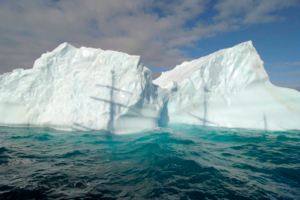
Chopin’s Funeral March marked her death.
As each record finished, the captain threw it into the fire. One by one, as the icy water slowly filled the ship’s belly.
He stepped off, bidding the ship farewell. She dove to her grave. The sober march a final tribute to the only home he had known for the last 208 days.
Now the crew were on their own. Alone.
The ship carried along by the aimlessly drifting ice, they were as good as dead.
History would deem the expedition doomed from the start.
Months prior, their questionable leader had emerged from a white wilderness, having spent the previous six years living amongst the Inuit of northern Canada. Vilhjalmur Stefansson hoped to build upon his success.
The Canadian government––granting his wish––appointed the 27-year-old anthropologist to lead an expedition to the uncharted waters surrounding the North Pole, in the hopes of discovering a long-lost continent Stefansson was sure to find.
With winter approaching, there was little time to prepare. Paths through the arctic shore-up and freeze come wintertime.
Major expeditions often took years to plan. But for the largest artic expedition in Canadian history, a few months would have to suffice.
So Stefansson set out to find a ship and a crew––not unlike his famous colleague Shakleton had done just a few years prior––when he recruited for his expedition to the opposite pole by posting perhaps the most successful job ad ever published, garnering over 5000 responses from London alone.
“MEN WANTED for hazardous journey. Small wages, bitter cold, long months of complete darkness, constant danger, safe return doubtful, honor and recognition in case of success.”
They came for Shakleton as they came for Stefansson–– from all over the world––very few with any expedition experience, much less experience surviving the frigid conditions of the Arctic.
Their vessel was equally underprepared, but at ten thousand dollars it was a bargain, and one of the few ships available on short notice.
The Karluk was dilapidated, far past her prime. Unlike the newer steel ships of the day, her wooden hull wasn’t built for forging a trail through the floating arctic icepack.
Nor could her engine provide sufficient thrust. Using sails and auxiliary power, she could scarcely achieve 7 knots. Her captain would later note, “She had neither the strength to sustain ice-pressure nor the engine-power to break loose ice.”
But captain Abraham Bartlett accepted the position anyway, albeit in the face of his own objections: the Karluk herself posed a serious danger to the success of the expedition, and the survival of her crew.
His fears would soon materialize.
The Karluk set sail from British Colombia on June 17th, 1913.

They sailed up the Alaskan Coast, reaching the Bearing Straight, then crossing the Arctic Circle by late July.
No ice was yet in sight. Optimism was high.
Four days later, on August 2nd, the winter’s first blizzard hit. A full month early. As the storm winds abated, their foe appeared: heavy sea ice off the port bow.
The Captain implored Stefansson to turn back, back to Alaska, to winter in harbor.The request was denied. The mission must continue.











Leave A Comment